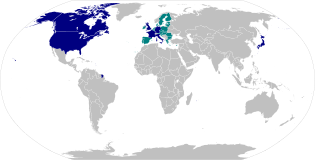G7
The Group of Seven (G7) is an international group made up of the seven largest IMF-described advanced economies in the world: Canada, France, Germany, Italy, Japan, the United Kingdom and the United States.[1]
| Group of Seven and the European Union |
|---|
 The G7-nations (blue) and the European Union (teal) in the world
|
In 2018, the seven countries represented 58% of the global net wealth ($317 trillion)[2] and more than 46% of the global gross domestic product (GDP).[3] The European Union is an invitee to G7.
History
changeThe group began in the early 1970s. The number of members has changed over time. Representatives from four leading economies first met in 1973. The representatives were finance ministers from France, the United Kingdom, the United States and West Germany. Later that year, the four members agreed to invite Japan to attend. These five came to be known as the "Group of Five".
In 1975, Italy was invited to attend the first heads-of-government summit, forming the "Group of Six", or G6. Canada joined in 1976, making the G7. The group meets every year, with a different host and president each year. The president of the European Council has attended since 1977. Since 1987, the finane ministers of G7 countries have met at least twice a year at separate meetings.[4] In some years they have met four times.
From 1995, Russia attended informally, and they joined the group in 1998, creating the G8. On 2 March 2014, the other members of the G8 criticized the "Russian Federation's violation of the sovereignty and territorial integrity of Ukraine."[5] As a result, Russia was removed from the G8 which was later renamed G7 as there are now seven leaders in the group.
Country leaders and EU representatives (as of 2021)
changeWealth data
change| Member | Trade mil. USD (2014) | Nom. GDP mil. USD (2014)[6] | PPP GDP mil. USD (2014)[6] | Nom. GDP per capita USD (2014)[6] | PPP GDP per capita USD (2014)[6] | HDI (2017) | Population (2014) | Permanent members of UN Security Council | DAC | OECD | Economic classification (IMF)[7] |
|---|---|---|---|---|---|---|---|---|---|---|---|
| Canada | 947,200 | 1,785,387 | 1,595,975 | 50,304 | 44,967 | 0.926 | 35,467,000 | Advanced | |||
| France | 1,212,300 | 2,833,687 | 2,591,170 | 44,332 | 40,538 | 0.901 | 63,951,000 | Advanced | |||
| Germany | 2,866,600 | 3,874,437 | 3,748,094 | 47,774 | 46,216 | 0.936 | 80,940,000 | Advanced | |||
| Italy | 948,600 | 2,167,744 | 2,135,359 | 35,335 | 35,131 | 0.880 | 60,665,551 | Advanced | |||
| Japan | 1,522,400 | 4,602,367 | 4,767,157 | 36,222 | 37,519 | 0.909 | 127,061,000 | Advanced | |||
| United Kingdom | 1,189,400 | 2,950,039 | 2,569,218 | 45,729 | 39,826 | 0.922 | 64,511,000 | Advanced | |||
| United States | 3,944,000 | 17,348,075 | 17,348,075 | 54,370 | 54,370 | 0.924 | 318,523,000 | Advanced | |||
| European Union | 4,485,000 | 18,527,116 | 18,640,411 | 36,645 | 36,869 | 0.899 | 505,570,700 | — | — | Emerging and Developing/Advanced[8] |
List of leaders
changeAlso see
change- Group of Eight (G8)
References
change- ↑ "World Economic Outlook Database". International Monetary Fund. imf.org. October 2017. Major Advanced Economies (G7).
- ↑ Research Institute – Global Wealth Databook 2018[permanent dead link]
- ↑ "Report for Selected Countries and Subjects". www.imf.org.
- ↑ "G7/8 Ministerial Meetings and Documents". G8 Information Centre. University of Toronto. 2014. Archived from the original on 16 February 2019. Retrieved 14 March 2014.
- ↑ "Statement by G7 Nations". G8 Info Ctr. University of Toronto. 2 March 2014. Archived from the original on 21 August 2019. Retrieved 10 March 2014.
- ↑ 6.0 6.1 6.2 6.3 "Gross domestic product". IMF World Economic Outlook. October 2015. Retrieved 14 October 2015.
- ↑ "World Economic Outlook data". IMF. 2014. Retrieved 19 October 2014.
- ↑ 23 out of 28 EU countries are classified as advanced. 5 out of 28 EU countries are classified by the IMF as Emerging and Developing Europe